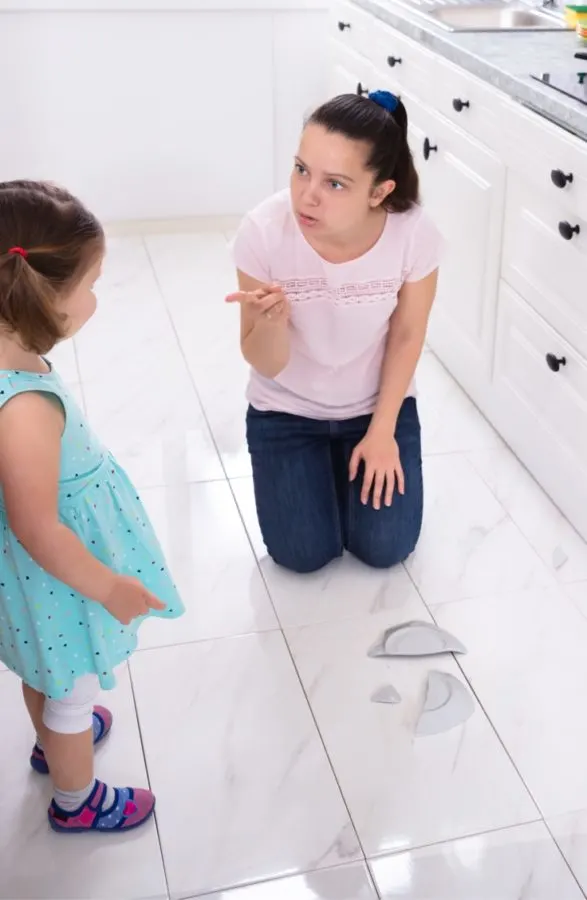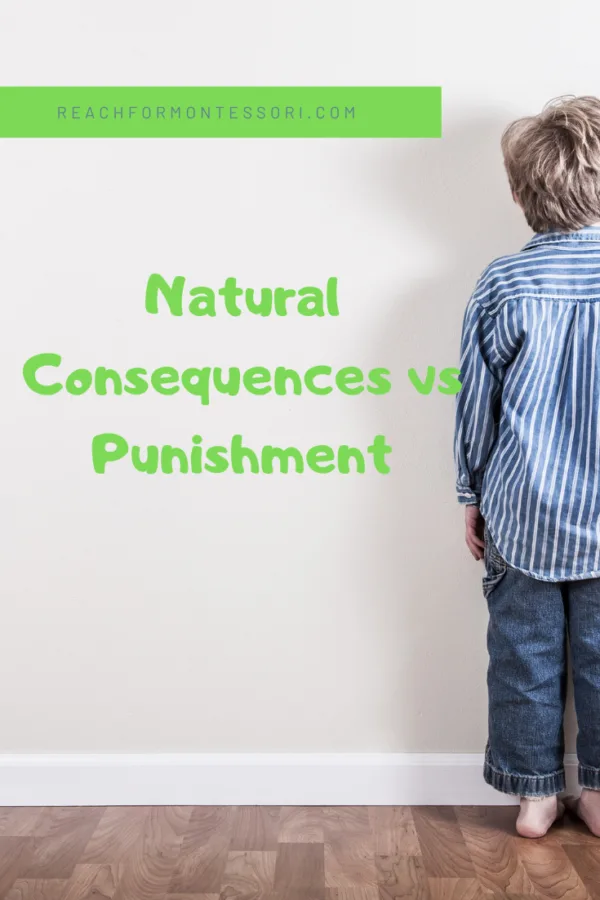The word “consequence” gives rise to negative images of punishment and cruelty for many. A consequence is not always a punishment, however. Natural consequences, in fact, happen without any adult intervention at all.
In this article, you will learn the difference between natural consequences and punishments.

What are natural consequences?
Natural consequences are the results of behavior choices. (Related to control of error) Instead of an adult-imposed consequence, the child gets to experience the consequences of their choices.
Example 1: It's cold outside and your child wants to go outside to play, but they refuse to put a jacket on despite your suggestion that they do so.
When they get outside, they quickly become uncomfortably cold. They ask to return inside to get their jacket.
Your child got a chance to make a choice and they experienced the natural consequence of that choice.
Example 2: It's hot outside and you are about to go on a walk around the neighborhood. Your child chooses to wear a sweater knowing that it is a hot day.
She may really like the sweater or she may just be in an oppositional mood. As you are walking along, she takes her sweater off and asks you to carry it for her.
To let her experience the natural consequence of her choice to wear a sweater, you would not carry it for her. She would have to carry it for the duration of the walk.
Example 3: You have introduced glass dishes to your child. You have modeled for her how to carry them and emphasized their fragility. However, as children will do, she picks up a plate and smashes it on the floor to “test” you.
The natural consequence of this is having her help you clean up the broken glass from the floor. (This could be a natural or logical consequence, depending on the ability and willingness of the child.)
Example 4: Your child is being destructive with the Practical Life materials you have set out for her. Instead of working with her Button Frame, something she typically enjoys, she is throwing it. She is ignoring your redirection.
The natural consequence for this behavior is her Dressing Frames being removed for the time being until she has reached the understanding, with your guidance, that this material has a purpose and isn't for throwing.
Example 5: You are grocery shopping with your child and she is pushing along one of those adorable little carts and helping you with your grocery list. She starts running with the cart and ignores your request for her to stop.
You explain to her that she could hurt herself, someone else, or damage property, but she's having a classic toddler moment and continues to run.
The appropriate consequence is that she no longer gets to push her cart. She will have to sit strapped into the seat of your regular grocery cart. This is actually a logical consequence, however, it is gentle and Montessori-aligned.

In these examples, letting your child make their own choices helps them feel empowered, reduces power struggles, and allows your child a chance to learn how their behavior has consequences, however unpleasant.
While an example or two may give off the “punishment” vibe to some, it's important to understand that allowing a child to experience natural consequences doesn't mean you as a parent never involve yourself. This is especially true in circumstances where other people could get hurt or property could get damaged.
What is punishment?
Punishment is a caregiver-imposed consequence that is made in an attempt to reduce or eliminate an unwanted behavior in a child. While punishment can be effective in the short-term, it has its drawbacks.
The unwanted behavior usually reappears after the consequence is finished. Take spanking and time-outs as examples.
If spanking and time-outs worked, in theory, you would only have to give these punishments once. However, if you know parents who do these things, you may notice they are repeatedly delving out these punishments.
More important than a punishment's ineffectiveness, is that it doesn't give the child any feedback or alternatives on more appropriate behaviors. Instead of focusing on what a child should not be doing, the focus should be placed on guiding the child on how to behave appropriately.

Types of punishment
Punishment by Application– This is when a parent does something unpleasant to a child to discourage unwanted behavior. Some examples of Punishment by Application (Also called Positive Punishment.) are:
- Yelling at a child.
- Forcing a task following the behavior.
- Adding chores.
- Implementing more rules.
- Spanking.
Punishment by Removal– This involves taking away something the child enjoys following the undesirable behavior. Some examples of Punishment by Removal (Also called Negative Punishment.) are:
- Taking away a toy.
- Not doing an enjoyable activity that was promised or expected.
- Isolating the child via “time-outs” or sending them to their rooms.

Why choose natural consequences over punishment?
Children's brains are rapidly developing, especially in the first six years of life. This is the period in their lives when logical reason is forming.
Consequences should make natural sense to the child, and their environments and relationships with their caregivers kept positive.
This is a brief summary of the difference between natural consequences and punishment, and why natural consequences are preferable. Parenting is far more complicated than can be summarized on an internet article, though.
There are some instances wherein letting a child experience natural consequences is not a viable option. (Running into the street, ect.) In these cases, try to remain consistent with whatever punishment you choose to implement and always make sure to help your child develop their reasoning skills by discussing the situation with them.
It's preferable to curtail behaviors, (We'll use running into a street as an example.) by allowing natural consequences early on, such as:
If you are out walking around the block with your toddler and she starts to run into the middle of the street and is ignoring you, you could end the walk.
You could also take a stroller along (just in case) and continue the walk, but have her safely strapped in. This will be unpleasant for her, as kids enjoy their freedom.
I hope you found this post informative! Feedback is always welcome!
Cheers, and don't forget to subscribe!



Kaylee
Saturday 20th of March 2021
I’ve read Parenting with Love and Logic which teaches this concept of natural and logical consequences. When my toddler is yelling or generally “not playing nice with others” our natural consequence is that she needs to be alone and play by herself until she is calm and ready to play with us or her friends in a nice way. Some would call that “time-out” but what would you say? Is that the correct consequence in those instances?
Sue Denym
Saturday 20th of March 2021
Kaylee,
That is such a great book. How does your daughter react to the time alone? Is it distressing to her or does she seem to benefit from the quiet time alone?
I would not use time alone as a consequence, however kids get overstimulated and really do benefit from solo time every now and then. It would be, however, a logical consequence that a child who is hitting or throwing, ect. is removed from an activity.
In those situations, I would do a "time-in" with your daughter to give her some affection (if she wants it) and talk through her emotions with her. Then ask her what quiet activity she'd like to do until she's ready to re-join the activity.
The goal here would be to help her understand how she's feeling so she can step away on her own when she's feeling overwhelmed. "Calming corners" are good for this. -Sue
Brittany
Thursday 10th of December 2020
I find it confusing that the natural consequences include removing preferred work stations and not allowing them to play with toys, but then an example of (discouraged) punishment is taking toys away. How do you differentiate?
Megan D.
Saturday 28th of November 2020
In your example about carrying their own sweater for the remainder of the walk...what would you do if the child then refuses and throws the jacket onto the ground? Also, at what age does enforcing the consequences begin? Do you naturally start to notice your own child’s understanding of situations?
Thank you!
Montessori vs Daycare — The Montessori-Minded Mom
Sunday 6th of September 2020
[…] Additionally, the teacher will try to focus on why the behavior occurred. Maybe the child was frustrated, or the other student decided to take the block away. Reasoning and critical thinking are introduced from a very young age, which results in more confidence and a way to think about the consequences of their actions. […]
Lauren
Tuesday 26th of November 2019
Love this concept but have a hard time understanding how it works for the younger toddlers in certain circumstances. For example , hitting mommy. We do timeout for that. What would a “natural consequence” be? Or the other one she does regularly is not come downstairs when it’s time to come downstairs (and I cannot carry her down). She gets timeout for not obeying. What would the natural consequence for that be?
Sue Denym
Wednesday 27th of November 2019
There are always tricky situations in parenting. The natural consequence for hitting would simply be for the parent to not let them hit you. Take their hand and firmly, say, "I won't let you hit me.", then show them how to use their hands to gently touch you.
The coming down the stairs situation really just depends on what she needs to come down the stairs for. If it's for breakfast, the natural consequence is that she's hungry until she walks down the stairs. If it's to go somewhere fun, she no longer gets to go on the outing. It really just depends. There are situation wherein you need a child to do something and natural consequences are difficult to see through.